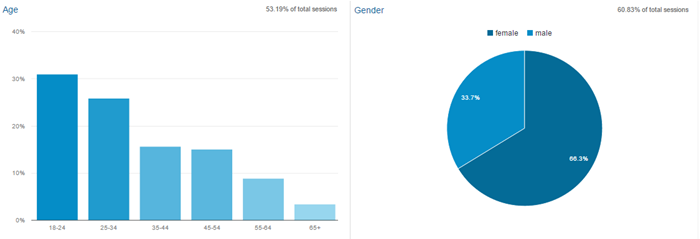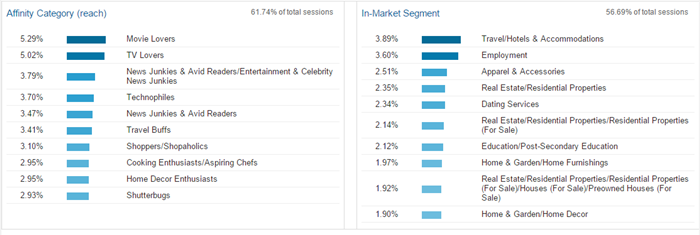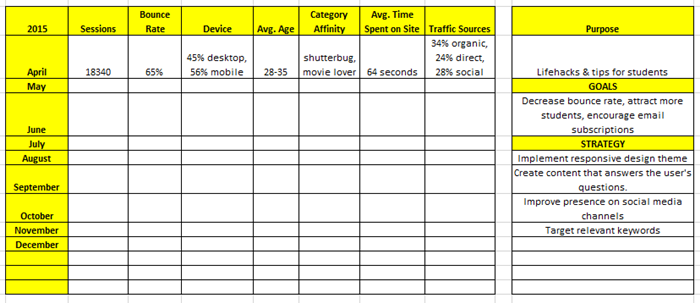When Your Blog Attracts the Wrong Readers, What You Can Do About It

Editor’s note: This post was written by Ioana, a trained architect, with a longstanding passion for writing and technology. Ioana always manages to impress with her exceptional work. She is a delightfully talkative person and she can always lift everybody’s spirits with her upbeat personality.
You’re crafting compelling and engaging articles, your content marketing strategy is rock solid, and the page-views are increasing at a steady pace. For most marketers, this is the dream. But something doesn’t feel quite right. These precious followers are not converting, or they’re not reaching your set goal.
Why is that? Despite their best efforts, marketers and writers will sometimes attract the wrong kind of readers, and for most, this seems like such a disheartening obstacle that they give up all-together.
Have you ever considered that, while your marketing strategy is brilliant, it may be targeting the wrong audience? This problem is not uncommon. As a matter of fact, most start-ups create outstanding assets without fully understanding what demographic they are actually pursuing. If your website falls into this category, your efforts are being wasted. You have to change your approach.
In the following guide we will answer three very important questions:
- Who is actually visiting my website?
- Why are these people on my website?
- What can I do to attract the right audience?
For this purpose, I will be using Google Analytics, SemRush and SimilarWeb.
Who is Actually Visiting my Website?
Before you jump to any conclusions you should know exactly who your audience is. With so much information readily available to you it is now possible to determine, not only who your readers are, but also what they like and how they are interacting with your content. Don’t listen to marketers who keep screaming “VOLUME! VOLUME!” because it’s NOT all about the volume.
I remember reading a case-study about a company that kept organizing giveaways with really cool prizes. Enticed by the idea of owning an iPad or iPhone, people would sign-up. But as soon as the give-away was over, they would leave. The few that remained didn’t generate a great conversion rate, and the business reached a standstill. Instead of focusing on numbers, focus on quality.
There are three types of data that will help you determine your target market:
- psychographics data (your users’ values, attitudes, interests, likes & dislikes)
- behavioural data (how they engage online, how they consume content what sites they frequent etc.)
- demographics data.
Let’s take a look at the demographics data. Head over to your Google Analytics tab to get started. Google Analytics offers exceptionally useful insights regarding your site’s users. There are a few metrics that you should know, including Location, Age, Gender, Traffic Source, and Top Performing Posts, among others.
From your Audience -> Overview tab you can check out the number of sessions, unique users, page-views, session duration, and bounce rate. The last two metrics will tell you a lot about how your visitors are interacting with your site. High bounce rate and Average Session duration generally means that people are exiting your site in a matter of seconds. In most situations, this means that there’s something they do not like on your page.
From the Audience -> Demographics tab you can check out their age and gender. These metrics are vital. For example, if your website focuses on fashion tips for men, you probably don’t want the audience to be 80% female. Alternatively, if you’re sharing tips & life hacks for students, you don’t want to have baby boomers hanging around. Getting an idea about who your audience is will also help you uncover new opportunities for growth.
Now head over to the Audience -> Interests -> Overview section. This tab usually holds the most important information about your readers’ interests. Based on a user’s searches and preferences, Google will assign him to an affinity category. Example: if you own a photography blog, your affinity category should be “Shutterbugs”, but this doesn’t mean that Tech lovers should be excluded. Determine the affinity categories that are likely to convert on your blog and craft content that solves their problems.
The engagement level tab, which can be found in the Audience -> Behaviour -> Engagement tab tells you how much time visitors spend on your site. Having thousands of visitors per month may sound great, but if they spend less than 30 seconds on your site it is a strong indicator that you are targeting the wrong audience.
There are at least two more metrics that you need to check: Type of Device Used (from the Audience -> Mobile -> Overview or Devices tab) and Traffic Sources (from the Acquisition -> All Traffic -> Channels tab). Needless to say, if more than 60% of your visitors are coming from mobile devices, and your website isn’t even optimized for mobile use, you’re mingling with the wrong crowd.
As far as traffic sources are concerned, they provide incredible insights on your users’ behavioural patterns. You can dig even deeper into this data to find out from which exact source they are coming by clicking on “Organic”, “Direct”, “Referral”, “Social” etc., or by visiting the Referrals or Source/Medium tabs. From the Overview -> All Traffic tab you can check out the bounce rate of specific traffic sources. Find out which visitors are quickly leaving your website and try to create a better experience for them.
Online marketers also reference the term “user intent” often. According to SearchEngineLand, user intent falls into one of three categories: do something, know something, go somewhere. But user intent isn’t limited only to organic search. For instance, the vast majority of people who spend time on Facebook are interested in funny cat videos, not your latest product launch. Each traffic source carries with it information about your users’ interests. You should start building around that.
Organize your Data in an Excel Spreadsheet
You can organize the most relevant information in an Excel spreadsheet for later use. Make a habit out of extracting demographic, psychographic and behavioural data every month, as well as site performance, to determine if your strategies are working. Below is an example of how I organize my data.
Why are These People on my Site?
You probably already have a rough idea about how you want your target audience to be. Now you can compare it with your demographics data. Not quite what you had in mind, now is it? This is probably because you have been sending the wrong signals. Here are a few common reasons why your website might be attracting the wrong readers:
- You want more people to visit your website, so you start promoting yourself on different social channels, forums, discussion boards, websites, and pretty much anywhere you can think of. The message gets diluted. The purpose is lost. While it isn’t wrong to promote your blog across different channels, the truth is that not all channels are worth it (CopyBlogger recently closed its Facebook page because it wasn’t worth the trouble). Instead of spreading your efforts thin, you should focus on a platform that fits your blog best. Focus on building a loyal readership there.
- Another reason why blogs attract the wrong audience is because they do not align their campaign with their growth potential. Remember the giveaway example? Organizing giveaways or offering freebies isn’t a wrong strategy, but giving away stuff that has nothing to do with your website is.
- You don’t know who you’re writing for. This is probably the biggest reason why blogs attract the wrong kind of traffic. While the idea of writing for thousands of readers may sound enticing, it is also the fastest way of killing your writing voice. Writing for the masses will make you sound generic, and nobody is interested in generic.
- You’re targeting the wrong keywords. Believe it or not, high Volume or CPC keywords don’t always make for great article topics. Especially if they are not relevant for your article. Sure, they will secure some organic traffic. Irrelevant, low-converting organic traffic.
What can I do to attract the Right Audience?
According to a recent IconicDigital study, you are irrelevant to 86% of your audience. So how exactly are you supposed to become relevant? The first thing you need to do is to identify your target audience. The following list of questions should help you determine your key followers:
- What do you want from your target audience?
- What kind of people are most likely to achieve your goal?
- What is your target reader like?
- Can you offer the things that your target audience needs?
- Are they new or returning visitors?
- Where do they get their information from?
- Are you focusing the right target group?
- Is your relationship with the audience mutually beneficial?
1. Persuade Visitors to Actually Read & Interact with your Content
It takes a great deal of time to create high-quality content, and knowing that it isn’t even read can be very frustrating. Most successful bloggers use heat-map tools like CrazyEgg and SumoMe to find out how their audience is consuming content. According to their findings, the huge majority of readers don’t make it past the first 20-30% content mark.
On the bright side, most of them responded positively to images, links, headlines and highlighted text. Even if long-form articles have smaller chances of being read all the way, they offer other huge benefits, so you should try to draw your readers in with interesting formatting tricks, alternative forms of content (podcasts, videos, images, infographics etc.) and text breaks.
Follow the ‘Inverted Pyramid’ Model used by newspaper journalists. According to it, more than 60% of your readers will never finish reading your article. Place essential information at the beginning of the article to increase engagement.
The next thing you should consider is the device on which content is consumed. You have already obtained this information from your Google Analytics. If more than 20% of your visitors are coming from handheld devices it’s time you adopted a responsive theme.
Most new bloggers write great articles, but they do not promote them at all. This is like holding a speech in an empty room. Simply creating exceptional content and waiting for something to happen won’t cut it. Instead of publishing articles every day, why not spend your time promoting it? The best way to attract relevant traffic to your blog is by ‘snatching’ readers from other websites.
2. Amplify your Content Strategy with User Personas
I strongly believe that bloggers should first write for their readers, and then for search engines. This is the only way to write content that moves. Creating a persona will not only bring you one step closer to your ideal audience, it will also help you tailor powerful messages.
“Personas are fictional, generalized characters that encompass the various needs, goals, and observed behaviour patterns among your real and potential customers. They help you understand your customers better.” (Source: HubSpot)
Creating a persona is difficult and time-consuming, but it will enable you to truly capture the demographics, attitudes, interests, fears, aspirations and values of your audience. This list is far from exhaustive, and you can include as much information as possible. The next time you write an article, write with this persona in mind. Your voice will become personal, concise and clear.
3. Try to Understand SEO
Search engine optimization isn’t some strange kind of dark magic that you can use to manipulate SERPs. Writing content only with search engines in mind isn’t going to get you very far, but failing to implement basic strategies will also make you lose out on organic traffic. By identifying and highlighting relevant and timely keywords you can help Google understand what your page is about. User-experience is also a major part of SEO.
People who are quickly exiting your pages, high load-time, broken pages and other factors will negatively influence your rankings. If you’re new to SEO I suggest reading the Beginner’s SEO guide by Moz, the Beginner’s Guide to Keyword Research and following major publications such as Search Engine Journal, Quicksprout and Kissmetrics.
Furthermore, if you’ve already developed a user persona, you might want to focus your keywords strategy around it. Take into account parameters such as search volume, CPC, difficulty or competition, and the keyphrase’s form (long-tail keywords will always perform better than short tails).
4. Promote your Website on Social Channels
As I already mentioned, the best strategy here would be to focus on the social media channels that are right for your business. Naturally, you should have a basic presence on all major platforms, but your promotion efforts should be directed to one, maximum two channels. If you can’t decide what social channel would be best suited, simply take a look at your competitors.
When posting, you should stick to the 4-4-1 rule (40% curated content, 40% interesting & engaging content, 20% your own content). You can promote anything from eBooks and events to quotes, testimonials and infographics on social media. Sharing content from influencers in your niche and commenting on their pages will also increase your chances of getting noticed by them and, hopefully, have them follow & share your own work.
These are only a few ideas of what you can do. Remember: the most important thing is to work with your demographics data to find out why the wrong audience is coming to your blog. Monitor the performance of your competitors to find out what techniques they are applying to attract their ideal readers and experiment with them.
Hook your readers first: 4 Tips to Writing Great Headlines
Image Sources: depositphotos, Google Analytics










